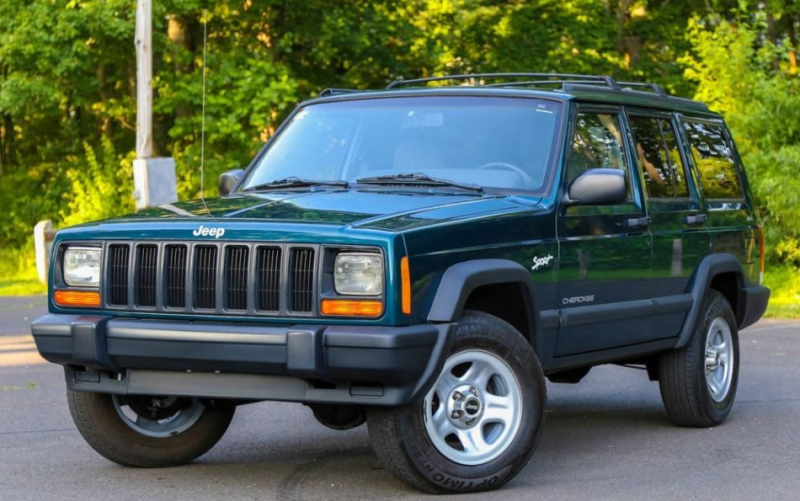
Today I spit my Lucky Charms all over my laptop screen after seeing this bone-stock Jeep Cherokee for sale on Ebay for nearly $16,000. The seller’s reasoning for selling the Jeep at such a lofty price was a typical one: it’s a one-owner car. My thought upon reading this: why should I give a crap?
I’ll admit that this is a beautiful Jeep Cherokee, even if it’s got an automatic transmission and the gray interior that I really wish were brown. But a Jeep in such condition regularly fetches $6,000, not $16,000. The $10,000 premium is there, it seems, because the Jeep has only had a single previous owner, and because it’s only got 45,000 miles on the odometer.
The answer to whether those two factors alone are worth the huge markup is, in my opinion, a firm “no.” There just isn’t enough information to justify that absurd price.
One Owner
It seems the world is obsessed with “one owner” used cars, with people like 1OwnerCarGuy on YouTube specializing in these Only-Once-Molested vehicles. One-owner cars tend to cost significantly more than ones that have changed hands a few times, and I really don’t get it.
Advertisement
Our beloved Doug DeMuro has written all about why people prefer one-owner cars, saying on AutoTrader:
If someone buys a new car and drives it for a decade, it’s likely that car received roughly the same level of care — and the same driving experience — throughout that time period. With multiple owners, a car may have been subjected to various levels of care and a wide range of different driving styles, which may negatively affect its long-term dependability.
He goes on:
Advertisement
Another reason why one-owner cars are so sought-after is that the original owner, who purchased the car new, likely has more financial resources to devote to maintenance and upkeep than, say, a sixth owner who buys the car when it’s 15 years old and costs $3,000.
These points all seem logical, but they’re based solely on assumptions. The only thing that matters is whether the fluids were changed on time, and if the wear parts were swapped when they needed to be. Driving style and consistency of maintenance be damned.
The notion that people who buy used cars are financial worse off than those who buy new ones is probably fair enough, but to say that used car buyers will maintain their cars significantly worse than those who bought the 20-year-old car new is also just an assumption, and is highly dependent upon the individuals.
Advertisement
The real benefit of a “one owner” car—and maybe this is what Doug meant by “roughly the same level of care”—is that the first owner has the best understanding of the car’s maintenance history. In other words, he or she already knows which parts have been changed over the Jeep’s lifetime, and what maintenance still needs to be done, whereas subsequent owners can only go off of records (or, in most cases, nothing at all).
This can mean that a second or third owner blows past the 60,000 mile differential oil change interval, the oil goes bad, and the differential bearing chews itself to pieces.
Advertisement
This, of course, assumes that the original owner paid close attention to the maintenance schedule, and that subsequent owners don’t change their oils and inspect wear parts as soon as they buy a used car. Again, this is a big assumption we’re making about a car we’re about to drop an extra $10 grand on.
Don’t get me wrong: if a car is only five years old, and it’s changed hands a dozen times, something might be up. But my point is that it doesn’t matter so much how many people owned the car, as much as it matters who owned the car. If a car’s three owners all kept strict maintenance notes, that’s a better purchase than a one-owner car with no maintenance history.
Low Mileage
As for how much we should value the fact that this $16,000 Jeep has only 45,000 miles on the clock, I’d say “not much.”
To be sure, fewer miles does equate to less wear of moving parts like U-joints, bearings, tie rod ends, ball joints, and fluids. But 45,000 miles is already encroaching on the end of life for some of those parts. In fact, that list of parts on the left from the listing shows that the owner has already had to do some fairly significant maintenance to the low-mileage, one-owner vehicle.
Advertisement
A 45,000 mile car that hasn’t been maintained is going to need quite a few new parts very soon, while a 120,000 mile car that has had its fuel pump swapped, all of its rubber seals replaced, and its steering and suspension parts swapped out may be a better purchase.
Plus, as we’ve covered before, leaving a car sitting can be just as detrimental as driving it.
Advertisement
My point with all of this is that maintenance history is 100 times more important than how many owners a car has had, or how many miles are on the clock. To spend $10,000 extra because you assume that first owner had a better grasp of the car’s required maintenance, and you assume fewer parts will need to be changed due to lower mileage seems absurd.
Why hinge $10,000 on assumptions?
















